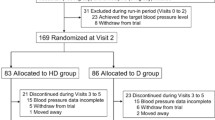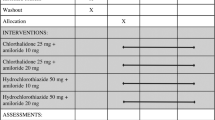Summary
A single-blind, single-center study was conducted to investigate the short-term safety and efficacy of carvedilol, a new cardiovascular agent, when added to 25 mg hydrochlorothiazide (HCTZ) as combination therapy for patients inadequately treated with HCTZ alone. A total of 18 patients entered the baseline study phase, during which they received 25 mg HCTZ once daily for 4 weeks; 16 of these patients (8 men and 8 women) entered the combination treatment phase. All patients had a supine diastolic blood pressure (DBP) of ≥ 95 mm Hg prior to receiving the first dose of combination treatment. Combination treatment consisted of 25 mg HCTZ plus 12.5 mg carvedilol once daily for 2 days, followed by a forced titration of the carvedilol dose to 25 mg for 7 days. After 2 days of 12.5 mg carvedilol plus 25 mg HCTZ once daily, mean trough blood pressure was reduced as compared with baseline values. Of 16 patients, 6 (38%) achieved a trough supine DBP of < 90 mm Hg. After 1 additional week of combination therapy with 25 mg carvedilol, 8 of 15 patients (53%) achieved a trough supine DBP of < 90 mm Hg and 14 of 15 patients (93%) achieved that of < 95 mmHg. At each visit during the combination treatment phase, the acute reduction in blood pressure was greatest during the first 2 h after dosing. The heart rate was minimally affected by combination treatment with carvedilol at either trough levels or acutely after dosing. Nine patients experienced adverse events during combination treatment. One patient withdrew because of dizziness and fatigue. In conclusion, at an initial dose of 12.5 mg once daily, carvedilol can be safely added to HCTZ in patients whose hypertension is inadequately controlled by HCTZ alone. Results suggest that some patients may be effectively treated with 12.5 mg carvedilol added to diuretics; upward titration of carvedilol should occur after adequate evaluation of the response to this initial dose.
Similar content being viewed by others
References
Hansson L (1987) Rationale for combination therapy. Br J Clin Pharmacol 23 [Suppl 1]: 15–19
Reid JL (1988) Hypertension 1988: present challenges and future strategies. J Hypertens 6: 3–8
Moser M (1987) Diuretics in the management of hypertension. Med Clin North Am 71: 935–946
Distler A (1987) Review of current therapeutic principles in hypertension. J Cardiovasc Pharmacol 10 [Suppl 1]: 134–138
Dupont AG, Van der Niepen P, Taeymans Y, et al. (1987) Effect of carvedilol on ambulatory blood pressure, renal hemodynamics, and cardiac function in essential hypertension. J Cardiovasc Pharmacol 10 [Suppl 11]: 130–136
SK&F report MC 009 BS. A multicenter, double-blind, randomized, controlled study comparing the efficacy and safety of carvedilol and pindolol in ambulatory patients with mild to moderate essential uncomplicated hypertension (MF3461). Internal Report O 21. Boehringer Mannheim, Federal Republic of Germany
Neugebauer G, Akpan W, Mollendorff E von, et al. (1987) Pharmacokinetics and disposition of carvedilol in humans. J Cardiovasc Pharmacol 10 [Suppl 11]: 85–88
Author information
Authors and Affiliations
Rights and permissions
About this article
Cite this article
Dupont, A.G., Schoors, D.F. & Venuti, R.P. The safety of adding carvedilol to hypertensive patients inadequately treated with diuretics. Eur J Clin Pharmacol 38 (Suppl 2), S153–S157 (1990). https://doi.org/10.1007/BF01409487
Issue Date:
DOI: https://doi.org/10.1007/BF01409487




